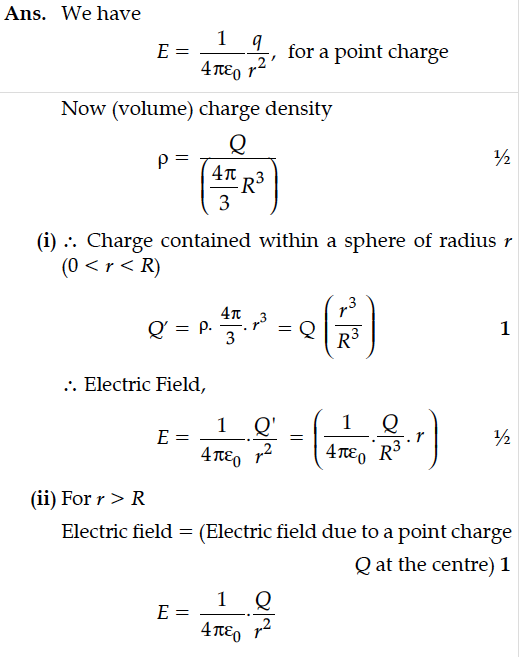A charge + Q, is uniformly distributed within a sphere of radius R. Find the electric field, due to this charge distribution, at a distant point r from the centre of the sphere where :
(i) 0 < r < R
(ii) r > R
(i) 0 < r < R
(ii) r > R

A charge q is placed at one corner of the cube. The electric flux passing through any one of its face is
A charge Q is enclosed by a Gaussian spherical surface of radius R. If the radius is doubled, then the outward electric flux will
(A) Increase four times
(B) be reduced to half
(C) remain the same
(D) Be doubled
If a charge q is placed at the center of the line joining two equal charges Q such that the system is in equilibrium, then the value of q is
(A)Q/2
(B)-Q/2
(C)Q/4
(D)-Q/4
Derive an expression for electric field of a dipole at a point on the equatorial plane of the dipole. How does the field vary at large distances?
A point charge +Q is placed in the vicinity of a conducting surface. Draw the electric field lines between the surface and the charge.
When 2 × \(10^{11}\) electrons are removed from a neutral metal sphere, the charge on the sphere becomes:
(A) -16 nC
(B) 16 nC
(C) -32 nC
(D) 32nC
Find the expression for electric field intensity in an axial position due to electric dipole.
The temperature coefficient of resistivity, for two materials A and B, are 0.0031 / °C and 0.0068 / °C respectively.
Two resistors R1 and R2, made from materials A and B, respectively, have resistances of 200 Ω and 100 Ω at 0°C. Show on a diagram, the 'colour code', of a carbon resistor, that would have a resistance
equal to the series combination of R1 and R2, at a temperature of 100°C.
(Neglect the ring corresponding to the tolerance of the carbon resistor).
A source of ac voltage V = V₀ sin ωt, is connected across a pure inductor of inductance L. Derive the expressions for the instantaneous current in the circuit. Show that average power dissipated in the circuit is zero.
An inductor L of inductance is connected in series with a bulb B and an ac source. How would brightness of the bulb change when
(i) number of turns in the inductor is reduced,
(ii) an iron rod is inserted in the inductor and
(iii) a capacitor of reactance is inserted in series in the circuit. Justify your answer in each case.
What is relaxation time ? Derive an expression for resistivity of a wire in terms of number density of free electrons and relaxation time.
The following table gives the length of three copper wires, their diameters, and the applied potential difference across their ends. Arrange the wires in increasing order according to the following :
(i) The magnitude of the electric field within them,
(ii) The drift speed of electrons through them, and
(iii) The current density within them.
A charge is distributed uniformly over a ring of radius ‘a’. Obtain an expression for the electric intensity E at a point on the axis of the ring. Hence, show that for points at large distances from the ring, it behaves like a point charge.
Four point charges Q, q, Q and q are placed at the corners of a square of side ‘a’ as shown in the figure.
